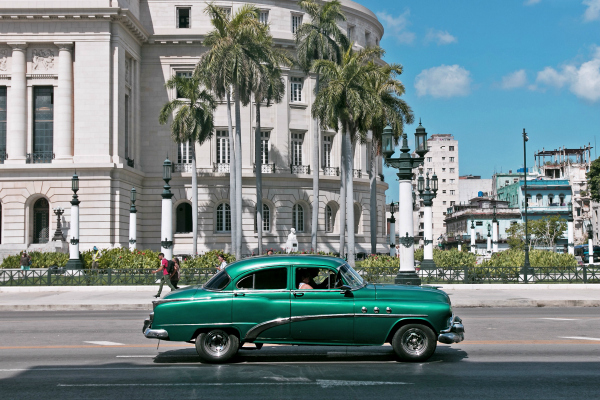Note: Today's guest author is my husband, Gary Ballesteros. I hope you enjoy his travelogue from Cuba!
I think I can trace back my desire to visit the forbidden island of Cuba to the Rodriguez clan, one of only two Hispanic families living In Murphysboro, the small rural Illinois town where I grew up. My family, headed by my Colombian father from the cool mountains of Bogotá, tried hard to fit in. But the Rodriguez family, a boisterous group of Cubans who fled Castro’s communist revolution only to somehow land in southern Illinois, did whatever they wanted. The patriarch of that family, Dr. Raymundo Rodriguez, had slicked-back hair, a hearty laugh, and a Spanish accent as thick as Cuban coffee which he used to great effect to spin hilarious and entertaining stories of the good life in old Havana. He wore open-necked guayabera shirts and despite his medical degree, was never without a drink in one hand and a cigar in the other. His sprawling family included a wife who escaped our small town as often as she could to take “dancing lessons” in Miami. (The joke around town was that absolutely everybody loved Dr. Rodriguez except for his wife.) He also had several beautiful daughters and several adventurous sons and I was smitten with all of them.
I finally got the chance to see Cuba last month by joining a tour sponsored by the wonderful Latino Arts Council of Milwaukee, and led by Raul Galvan, a local Milwaukee Cuban expat and expert. The tour promised to focus on the vibrant music scene in Cuba. And because our son George is a budding jazz musician, this tour was perfectly simpatico with what we both needed. I hope you enjoy this tour!
It’s routine to be approached on the street by Cubans who start a conversation by complimenting your clothes, or asking where you’re from. My son Atticus, who visited Havana last year, described the typical Cuban street conversation as a sandwich: It starts with friendly curiosity. Then it moves into the meaty part - a sales pitch. But the moment you say you’re not interested, they back off and it returns to the other slice of bread, friendly curiosity.
A barbershop visit is always on George's agenda and this place was a popular hangout for men just killing time. Throughout Cuba, the normal Latino warmth is further baked by the Caribbean sun, spiced with a bit of naughtiness, and then simmered with an insatiable curiosity about all things American. Everyone on the island seems to have a cousin in New York or an aunt in Miami, and everyone wants to talk to you.
The music! We went to Cuba to sample the music and came home gorged. Music was everywhere. More than New Orleans or Nashville, you simply walk down the street in Havana and stumble upon a band of musicians.
The Cubans are incredibly resourceful, and they let nothing go to waste. There are no restaurants, but urban farms and rooftop gardens are plentiful in Havana. We saw old boots used as planters, and here, toilets. The scrappy Cubans improvise with what they can.
Hemingway’s home, where Ava Gardner swam nude in the swimming pool, where he hoarded 9000 books, where he marked his weight while sitting at the toilet, is truly remarkable and incredibly well-preserved. I knew Mithra wouldn’t care so much about the Cuban cigars, or the old cars, or even the Revolución. But a beautiful historic house.... well I couldn’t leave Cuba without seeing it.
Hemingway's home is full of African game trophies, but one can only imagine what human creatures he took pride in slaying atop this mattress. He went through two wives and who knows how many mistresses at Finca Vigia, which translates to "lookout farm".
Four of Hemingway's dozens of pets are buried here, alongside The Pilar, his famed 38-foot fishing boat. Signs of El Papa are prevalent throughout Cuba, especially the places where he used to drink. There’s a fun bronze statue of him leaning into the bar at La Floridita; and his favorite mojito recipe is on the menu at La Bodeguita del Medio. In the small fishing village of Cojimar, which was reputedly the setting for "The Old Man and the Sea", residents say that they erected a monument to Hemingway long before he was really famous.
I've got nothing to say about this photo. Plates on walls always remind me of Mithra. I missed her on this trip.
Havana is a city of over 2 million people and yet I never witnessed the slightest bit of traffic. Easily more than half of the vehicles that are on the road are from prior to 1959. And it’s not uncommon to see a handful of cars from the ‘20’s or 30’s. You can also see (and smell) horrid old Soviet Ladas or boxy Russian claptraps nicknamed Moscovi’s. But for an old car buff like me, Cuba was like touring an auto museum.
I was struck by this potter's discards transitioning back into mud. Along with many musicians, Cuba also has a wealth of artists. And like the musicians, we were amazed at what artistry they could produce from primitive materials and equipment.
Viva La Revolución! The Cubans are very proud of what they’ve achieved since 1959. They’re realistic about their problems, but they genuinely revere Fidel, Che, and the ideals of the revolution. Signs of the revolution are prevalent everywhere, and history is very real and alive to the modern Cubans.
The Presidential Palace of the despised dictator Fulgencio Batista, who was finally overthrown by Fidel Castro in 1959, has now been turned into El Museo De La Revolución. You can still see the bullet holes of a failed assassination attempt from the onset of the revolution, as well as a bronzed cap of El Commandante Fidel, or a life-sized diorama of Che Guevara and Camilo Cienfuegos’ assault on Santa Clara. I believe someone wisely said that the victors get to write the history.
Faded Glory: The harsh tropical climate, the US trade embargo, and the poverty of an island, all conspire to be a relentless force wearing down the underlying beauty of Cuba. The level of crumbling was like nothing I’ve ever seen. Havana felt like an ancient city of ruins which was both beautiful and tragic at the same time.
We visited a music school housed in an ancient three story building with an interior
courtyard. The acoustics were terrible and thanks to the open air courtyard the sounds of each
classroom spilled out everywhere so that the school was a cacophony of noise. There was no
air conditioning, so a hot breeze blew through the open windows. The students used clothes pins to clip the music to their makeshift stands; and the classrooms were in short supply of anything we’d normally associate with teaching. But when they played in concert... wow! These kids were killer musicians. (Photo by Dave Chavez.)
There is also a shortage of boats, due to the fact that the more seaworthy vessels have been used to escape. Prior to 1995, the US allowed any Cubans who reached US land to remain here. President Clinton changed the rule to the so called "Wet Feet Dry Feet" policy in which a human caught on the waters between the two countries with "wet feet" would be sent home. One who makes it to shore with "dry feet" gets a chance to stay in the US.
If the Cubans are friendly in general, then the musicians of Cuba are on friendliness steroids. Perhaps it’s simply that music is a universal language, because every time a musician in Cuba learned that our son George was also a musician, he immediately welcomed George as a new member of the band.
I was in Miami the day President Obama announced that the US would be renewing diplomatic ties with Cuba. Fist fights broke out in the Little Havana neighborhood of Miami that day. The complicated and emotional history between our two countries was still so hot, the very thought of making peace with the Castros made blood boil. What is it about this small island only 90 miles from our shores that evokes such fiery passion?
We left Cuba with a much greater appreciation for the beauty of the island, the warmth of its people, the soul of its music, and the idiocy of politics that keeps people from simply being friends.
Over and over again we were met with open arms and welcoming smiles and a reaffirmation that the Cubans don’t reject America, or capitalism. But they are rightly proud of what they’ve been able to achieve on their own and they want to embrace new opportunities while still preserving the strides they’ve made in health care, education, literacy, and social services. I’m so glad we went — before the window of opportunity to do so slams shut again; or before the inevitable Americanization swamps their fragile state.

















